Niki De Saint Phalle
Niki de Saint Phalle was born Catherine Marie-Agnès de Saint Phalle on the 29 October 1930 in Neuilly-sur-Seine. Her father, André Marie de Saint Phalle, whose banking company went bankrupt during the Wall Street Crash of 1929, came from an old noble family from France. Her mother, Jeanne-Jacqueline Harper, a woman from the American upper middle class, suffered from depression due to her husband's infidelities. As her mother left to join her husband in the United States, she spent her early years with her paternal grandparents in France and reunited her parents, brother and two sisters in August 1933. This is where a few elements key to her artistic career came to be, as she was raised by a nanny she called Nana, foreshadowing the figure that would later inhabit her art, and her mother started to call her Niki.
At the age of 6, Niki displayed her creative skills through drawing complex forms and curved lines and later explored Greek tragedies, Shakespeare, and Camus at Brearley School in New York. She was a rebellious pupil who enjoyed games, theatre, and the stage and defiantly painted the genitals of her school's statues red at 14, which resulted in her parents sending her to a religious boarding school. At 17, she began her career as a model, posing for publications such as Elle, Harper's Bazaar, Vogue, and even gracing the cover of Life. To distance herself from the family, Niki married her childhood friend, poet and musician Harry Mathews, at age 18. The couple avoided social constraints as Harry studied musicology at Harvard and Niki focused on theatre. Their daughter Laura was born on the 31 April 1951.
The couple moved to Paris in 1952 and travelled to various places in the summer, including the South of France, Spain, and Italy. Niki de Saint Phalle was inspired by cathedrals and saw them as a symbol of collective ideals, which became a recurring theme in her artwork. In 1953, she experienced severe depression and was admitted to a psychiatric hospital in Nice where she discovered painting as a therapeutic outlet. The electroshocks she underwent altered her memory and her creative work, split between amnesia and hypermnesia, oblivion and resurgence of suffering. Niki perceived creation as a mean to exteriorise what was buried in her psyche. Despite facing resistance from her family and friends, she continued creating art with the support of her husband and the painter Hugh Weiss. She found inspiration in the work of Gaudí, particularly Park Güell, during her visits to Madrid and Barcelona in 1955. A year later, she completed a series of oil paintings and held her first exhibition in Switzerland and met Jean Tinguely, who became her partner and collaborator.
De Saint Phalle fully dedicated herself to her career as an artist at the age 30. She began her "shots" sessions, where she used a rifle to burst colour packets arranged on plaster, marking the beginning of her "Art-action", her public performance style. Her work gained recognition, and she joined the group of New Realists, which included prominent artists such as Arman, Yves Klein, and Jean Tinguely. Her first solo exhibition, "Feu à volonté" (All-you-can-fire), organised by Pierre Restany and took place in June 1961 at Galerie J, invited visitors to shoot at paintings. The following October, Niki de Saint Phalle exhibited her work at the MoMA in New York.
Niki de Saint Phalle created sculptures-collages with hearts and dragons that later became known as Nanas. Inspired by her friend Clarice Rivers' pregnancy, she showcased the first Nanas at Galerie Alexandre Iolas in Paris, initially using fabric and wool before transitioning to polyester and painted plaster. In June 1966, Niki was invited to install a large sculpture at the entrance of Moderna Museet in Stockholm. With the help of Tinguely, she created the highly successful monumental 91-foot-long pregnant Nana named Hon ("She" in Swedish) which visitors could enter through her genitals and discover different rooms and mechanisms inside.
Concerned about the traditional role of women in society, she created sculptures featuring witches, prostitutes, and pregnant women as symbols of women trapped in societal expectations. In 1967, the Stedelijk Museum in Amsterdam presented Niki de Saint Phalle's first museum exhibition, Les Nanas au pouvoir (Nana Power). The exhibition showcased the first Nana Dream House, Nana Fountain, and plans for Nana Town. The following year, Niki de Saint Phalle exhibited her work at the MoMa in New York as part of the Dada, Surrealism and Their Heritage exhibit.
During this period, Niki de Saint Phalle started to develop respiratory issues as a result of inhaling polyester dust, the material she stilled used for her sculptures. However, this did not deter her from persevering in her creative pursuits. After a trip to India, she started working on her first large-scale architectural project, Le Rêve de l’oiseau, Big Clarisse et la Sorcière, in the Var forest in southern France (Le Plan-de-la-Tour). Construction was completed in 1971. The same year, she collaborated with Jean Tinguely, whom she married, on Cyclop in Milly-la-Forêt, Essonne, which was completed in 1994. In 1971, after working on Nanas and Devouring Mothers, her perspective on women shifted and became more critical.
Niki de Saint Phalle's artistic journey was marked by significant milestones and achievements. In 1972, she created The Golem, a monumental sculpture inspired by Jewish culture. Her first autobiographical film, Daddy, a collaboration with influential filmmaker Peter Whitehead, symbolised a psychoanalytic reckoning with her father. 1974 witnessed the installation of three giant Nanas sculptures in Hanover, Germany. This period also marked the realisation of Niki's architectural dream, the Tarot Garden, which took twenty years to complete. The opening of the Tarot Garden to the public in 1998 showcased 22 monumental sculptures inspired by the divinatory tarot. In 1983, Niki collaborated with Jean Tinguely to create the mesmerising Stravinsky Fountain in Paris. This kinetic ensemble blended Tinguely's dark machines with de Saint Phalle's shimmering sculptures, paying homage to Igor Stravinsky's musical work. The artist's first monumental installation in the United States, the Sun God, was erected at the University of California, San Diego.
Niki de Saint Phalle's artistic legacy continued to thrive after her passing in 2002. The Niki Charitable Art Foundation, created to preserve and promote her work, remains actively involved in lending her personal collection. Her final architectural project, Queen Califia's Magical Circle Garden, was inaugurated in Escondido, California, in 2003. Throughout her life, Niki de Saint Phalle used art as a form of therapy, as demonstrated in her memoir Mon secret, dedicated to her daughter, where she revealed her traumatic experience of being raped by her father at age 11. Her work served as a powerful medium for personal healing and empowerment.

SELECTED WORKS
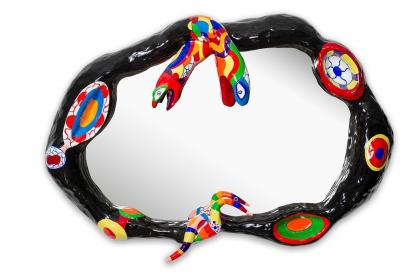
Niki De Saint Phalle, Le Miroir (Magie du miroir), 1980
Polyester, painted wood, mirrored glass
105,9 x 152 x 25,4 cm | 41.7 x 59.8 x 10 in

Niki De Saint Phalle, Fauteuil noir, 1980
Polyester paint
102 x 79 x 70 cm | 40.2 x 31.1 x 27.6 in

Niki De Saint Phalle, White Tree, 1972
Resin polyester joined on a wood panel
244.5 x 122 x 22 cm | 96.3 x 48 x 8.7 in

Niki De Saint Phalle, Ange vase, 1993
Painted polyester, iron base
99 x 57 x 32 cm | 39 x 22.4 x 12.6 in
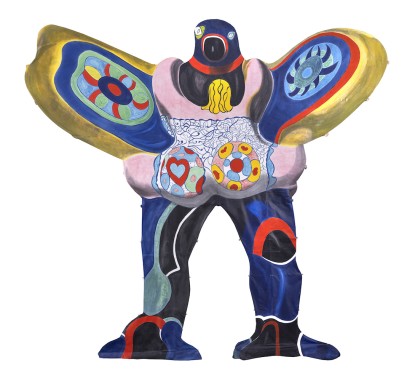
Niki De Saint Phalle, L'oiseau amoureux, 1988
Watercolour, coloured chalk and acrylic on japan paper laid on silk
260 x 285 cm | 102.4 x 112.2 in

Niki De Saint Phalle, The Blue Falcon, 1980
Painted polyester, metal, light bulbs and electric systems
66 x 37 x 21 cm | 26 x 14.6 x 8.3 in
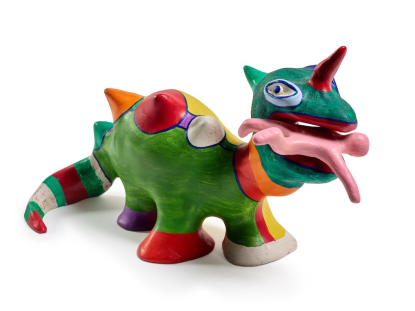
Niki De Saint Phalle, Untitled, 1979
Polyester resin and acrylic
17,8 x 30,5 cm | 7 x 12 in
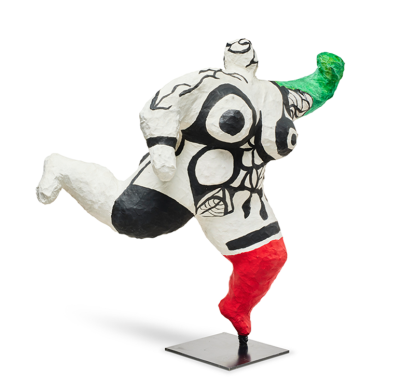
Niki De Saint Phalle, Nana courant, 1966
Painted papier-mâché
71 x 72,5 x 39 cm | 28 x 28.5 x 15.4 in
Niki De Saint Phalle, Oiseau amoureux, 2000
Painted resin
60 x 48 x 23 cm | 23.6 x 18.9 x 9.1 in

Niki De Saint Phalle, Lady with Handbag, 2000
Painted resin
63 x 36 x 10 cm | 24.8 x 14.2 x 3.9 in
Niki De Saint Phalle, Do You Like My New Dress, Black (Remembering), 1997 - 2000
Fiberglass and painted polyester
99 x 55,8 x 10,1 cm | 39 x 22 x 4 in
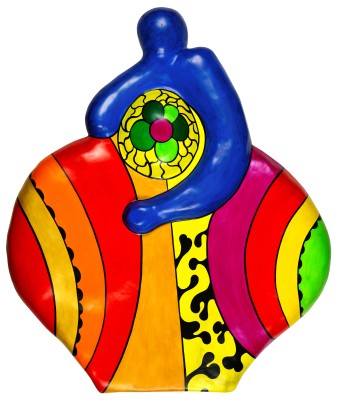
Niki De Saint Phalle, Collaboration (Remembering), 1998
Fiberglass and painted polyester
84 x 74 x 13 cm | 33 x 29 x 5 in

Niki De Saint Phalle, Cat Vase, 1986
Polyester resin, painted and glazed terracotta
39 x 32 x 21,5 cm | 15.4 x 12.6 x 8.5 in

Niki De Saint Phalle, Head, 1967-1968
Acrylic on papier-mâché
76,5 x 55 x 63 cm | 30.1 x 21.7 x 24.8 in

Niki De Saint Phalle, L'Oiseau amoureux, 1990-1992
Painted polyester
155 x 150 x 60 cm | 61 x 59.1 x 23.6 in
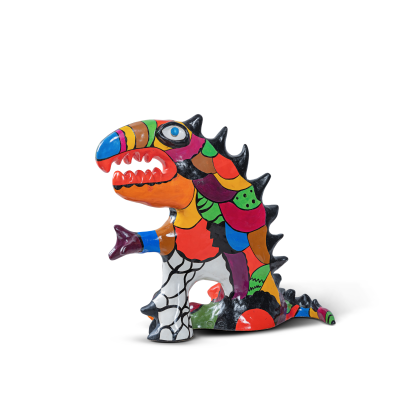
Niki De Saint Phalle, Dragon, 1974-75
Painted polyester
65 x 50 x 23 cm | 25.6 x 19.7 x 9.1 in

Niki De Saint Phalle, I am Upside Down, Green (Remembering), 1997
Acrylic on polyester resin
117 x 80 x 14 cm | 46.1 x 31.5 x 5.5 in

Niki De Saint Phalle, Clarice, Chaise Femme, 1982
Painted resin
122 x 113 x 81 cm | 48 x 44.5 x 31.9 in
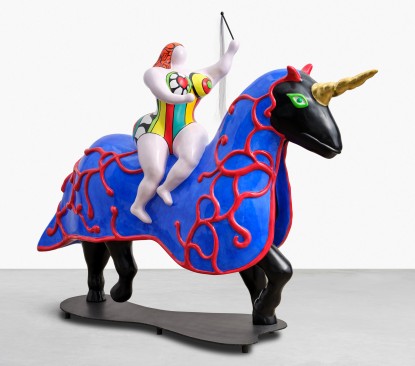
Niki De Saint Phalle, The Unicorn, 1994
Painted polyester resin on metal base
106,7 x 142,2 x 30,5 cm | 42 x 56 x 12 in

Niki De Saint Phalle, Dawn Jaune, 1995
Painted resin
144 x 114 x 57.5 cm | 56.7 x 44.9 x 22.6 in

Niki De Saint Phalle, Last Night I Had a Dream, 1968
Painted polyester
Variable dimensions cm | in

Niki De Saint Phalle, L'Oiseaux Amoureux, 1973
Painted resin
42 x 41 cm | 16.5 x 16.1 in

Niki De Saint Phalle, Nana et chien, 1986
Painted plaster
40 x 22 x 30 cm | 15.7 x 8.7 x 11.8 in
, 1966.jpg)
Niki De Saint Phalle, Dominique (jambe en l'air), 1966
Paint, fabric, glue and wire mesh mounted on metal base
116 x 113 x 52 cm | 45.7 x 44.5 x 20.5 in
.jpg)
Niki De Saint Phalle, Shamu - You Are My Killer Whale, 1997
Fiberglass and painted polyester
81.2 x 142.2 x 15.2 cm | 32 x 56 x 6 in